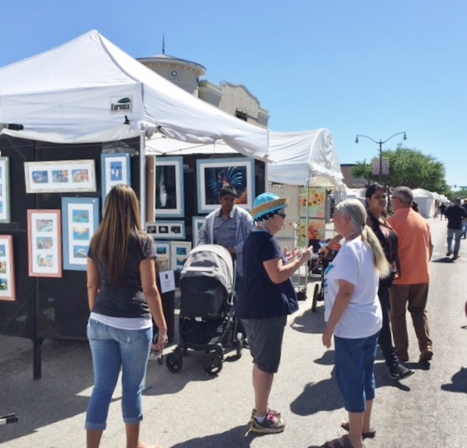by Carolyn Edlund
There are a lot of compelling reasons to consider your local community as a potential market for your artwork.

Many artists dream of reaching a broad audience, national or even international. However, the truth is that most sales still happen close to home. While the internet expands possibilities, your own community will often hold the most opportunity for you. When you focus your attention on local buyers and closeby venues, you have a greater chance to strengthen relationships, build a reputation and make repeat sales, simply due to proximity.
Face-to-face connections
A powerful advantage of selling your artwork locally is the ability to meet customers in person. Unlike online transactions, face-to-face interactions allow buyers to connect with you as an individual. They can shake your hand, start a conversation and get to know you. You’re not just a name behind a website, but a real and very interesting new acquaintance. Those in-person connections tend to create trust and can deepen appreciation for your work.
Tie your work to the area
If your artwork portrays local landscapes, landmarks, or cultural traditions, the bond with your prospective customer becomes even stronger. Imagine a collector who grew up in your area. They are likely to feel a natural pull towards art that captures a familiar view, especially when they’ve met you and heard the story behind it. Meeting you in person makes the purchase more than a transaction; it becomes a shared experience.
Local venues and events
Communities are filled with places where art can be seen and purchased. Your town may sponsor art fairs and festivals, and many cities have gallery exhibitions. These aren’t the only possibilities, though. Don’t overlook smaller opportunities such as open studios, art walks, or even farmers markets.
The benefit of showing locally is that logistics are simple. You save on travel and shipping, you can restock quickly, and your repeat presence at events builds familiarity with local shoppers. A customer who first sees you at a pop-up shop may spot you again at a festival, and by the third encounter, they’re ready to buy. That’s the mere exposure effect in action. Repeated visibility makes your work feel more desirable.
Commissions and custom work
Local connections also open the door to commissioned projects. When you meet clients in person to discuss what they are looking for, it’s more likely that you will be able to produce a finished piece that is exactly what they envision. Conversations about commissions not only generates income but also helps in buildinglong-term relationships. A satisfied client often becomes a repeat collector or will refer you to their friends.
Make your name as a local artist
It’s much easier to establish yourself as an artist in your community than to compete on a national scale. Positioning yourself as a local voice makes your marketing seem more authentic. Join art groups, collaborate with peers, and participate in local projects to heighten recognition.
Grow your visibility
As your local presence grows, doors open to broader exposure. Regional media outlets are always searching for human-interest stories, and artists make compelling subjects. A feature in your hometown paper or local TV news can establish you as a trusted voice, leading to speaking opportunities, juror invitations, or collaborations.
Follow these opportunities up with public demonstrations, artist talks, and community appearances. Give audiences a behind-the-scenes look into your process. When people understand the story behind the work, they feel more connected. And that connection can translate into sales.
Cultivate collectors close to home
Every event you participate in is a chance to grow your collector base. Meeting buyers at fairs or exhibitions is just the beginning. Get creative and think out of the box. Perhaps invite them to your studio for a private visit or a VIP preview. These experiences deepen loyalty and create a sense of exclusivity.
Small gestures go a long way. Offering free local delivery or personally installing a piece not only adds convenience but also gives you another opportunity to strengthen the relationship. Being in a client’s home, hanging the work yourself, and having a conversation with them about their preferences and needs often leads to future sales.
Grow your business network
Beyond traditional art venues, local businesses can be excellent partners. Retailers may host trunk shows or feature your work in-store. Interior designers, real estate stagers, and corporate buyers often want artwork that reflects the culture of the community. Museums, restaurants, and even hospitals frequently feature local artists to show pride in place.
Networking events are especially valuable. When you’re the only artist in the room, you stand out. That makes you memorable, and often leads to collaborations you couldn’t have predicted.
Why local still matters
Corporations, airports, restaurants, and public spaces often choose local artists because it demonstrates community support. Being visible and accessible within your region makes it easy for them to connect with you. These partnerships can generate sales and also position you as a cultural ambassador for your area.
In a world where art can be seen by a global community, it’s easy to overlook the opportunities nearby. Yet selling art locally offers affordability, convenience, and the human connection that creates lasting loyalty.
Take your next step
Think about one local opportunity you can pursue this month. It could be a community event. You may decide to reach out to a local business, or invite a collector to your studio. Small, consistent steps taken close to home can lay the foundation for a strong collector base and a reputation that brings in more art sales.
